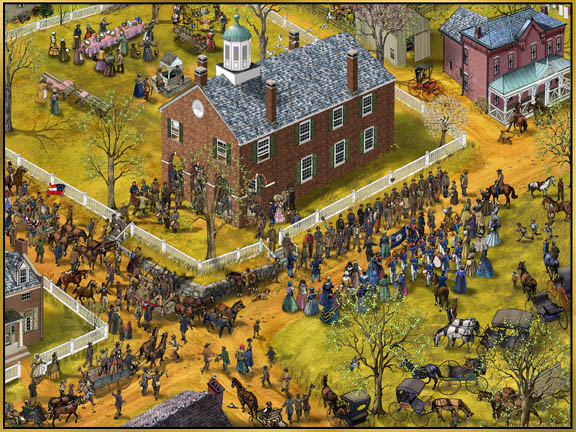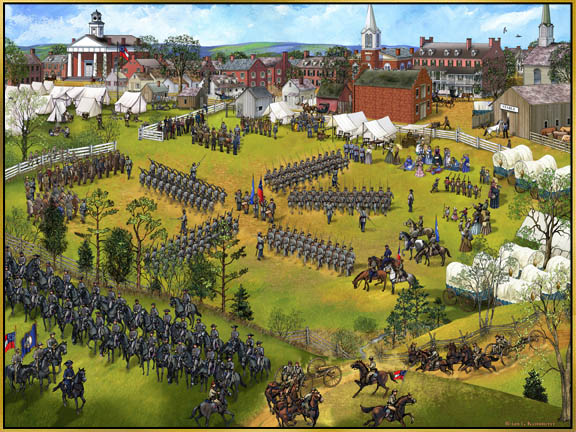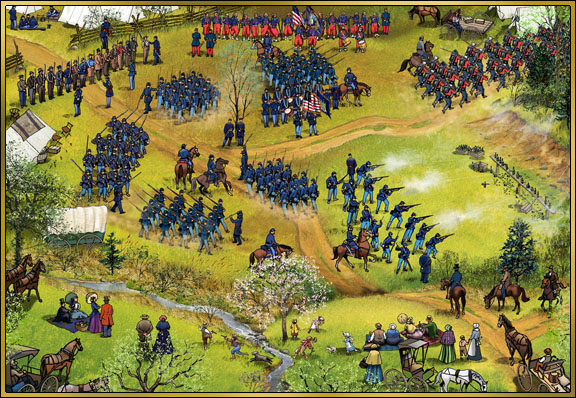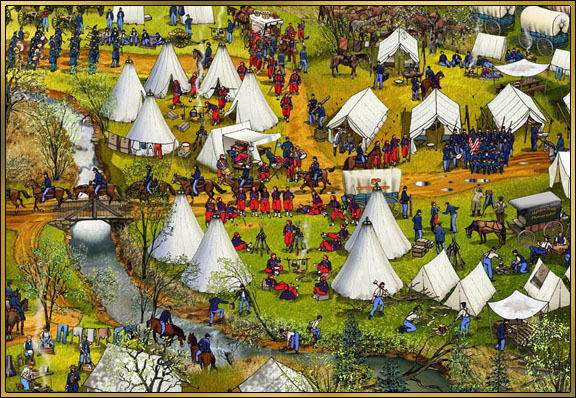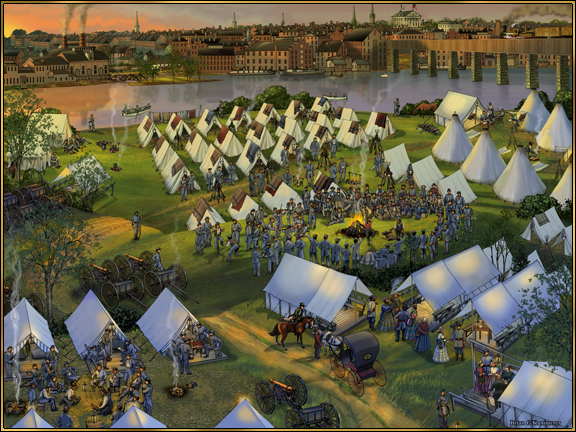
 |


Southerners Respond to Call
When Virginia seceded from the Union, its people rallied to defend the Old Dominion. Under orders from Governor John Letcher and General Lee, Brigadier General Phillip St. George Cocke began mustering volunteers from 18 different counties. The April sun was shining and spring was beginning to adorn the hills and valleys of Northern Virginia just south and west of Washington. Men and boys had heard the call to defend their home and flocked to the county seat to enlist. They had been charged by emotional oratory to expect a rush to battle, a few days of hard fighting and a triumphant return home. These were the days of hope and opportunity. They came from all over the county carrying firearms of all makes and models. Some shouldered muskets that hung over hearths, antiques from the Revolution, the War of 1812 and of the recent though distant War with Mexico. Some carried fowling pieces and shotguns as if they were off to shoot some game for the evening meal. Fife and drum now summoned them forward into line to sign their name and loyalty to the volunteer companies that would form the regiments. For the volunteers in the north it was for three months, in the south it was for a year. The volunteers were organized by the Governors of their states into regiments consisting of 10 companies of approximately 100 men each, with the companies usually grouped to a region. The companies adopted names like the Liberty rifles or Co. D the Fairfax Rifles. Resourceful young ladies would paint and stitch homemade banners for the boys to carry into battle with memories of home still warm in their minds. They were sent off with much fanfare to be absorbed into larger units that would make up the newly formed Army of the Confederacy.
Enlistment of Northern Volunteers
After summoning the State Militias' Lincoln envisioned the eventual need for more men. He now called for additional volunteers to serve three years. The federal government left the raising of its armies to state and local officials. Recruiters quickly opened offices in vacant stores or pitched tents in town squares to start the process. The men of the North responded by the tens of thousands, eager to enlist and get in on what they thought would be the adventure of a lifetime. Young men flocked to the colors to don the Union blue or the fancy colorful trappings of the Zouaves units to serve their country. After signing their name and a rudimentary verbal questioning by a physician the mustering officer made his appearance asking the men to hold up their right hands. The Officer would read the oath to swearing us in 3 years or the duration of the war, so help me “bob.” Spring had arrived, the trees were putting forth their buds, “we would be victorious and home before summer” some were heard to say. They were now full fledged soldiers, in the pay of Uncle Sam and something more than the common run of mortals. The companies of Firemen that enlisted as units wore their traditional work outfit, a double breasted red shirt and black neckerchief trading in their fire helmet for a fez and tassel.

Army of the Shenandoah, Winchester Va-1861
Click here to view close up cropped images of this print
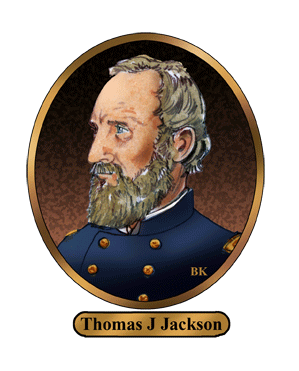
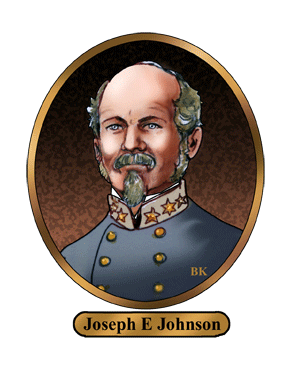 As one army was assembling in and around Richmond, other Virginians had begun building an army to defend the Shenandoah Valley. The U.S. Arsenal at Harpers Ferry had been seized on April 18 which closed the northern gateway to the valley. On April 29 the organization and training of the Valley army was turned over to an obscure VMI professor named Colonel Thomas Jonathan Jackson. Jackson with Eight officers and 176 cadets from VMI had marched north from Lexington Virginia. With this core group of trained men he diligently set about the task of building an army. General Joseph E. Johnson would supersede Jackson as commander the Army of the Shenandoah and change his base of operations to Winchester Va. believing Harpers Ferry indefensible to attack. Winchester was more defensible a position and controlled all the main roads into the Valley and also the vital Manassas Gap Railroad to the East. Within two months Colonel Jackson had organized four brigades, each with a battery of artillery and all sharing the services of the 1st Virginia Cavalry, commanded by J.E.B. Stuart. The force would number more than 10,000 strong and awaited there confidently for the enemy to advance.The camp was the place where the new soldier ceased to be a civilian and learned to become a soldier. Here his life would move to the rhythm of the bugle and the drum. He would be taught discipline, learn the manual of arms, how to march in line and in column. He had to learn how to become one with his comrades, an integral part of a machine, moving to the voice of a command.
As one army was assembling in and around Richmond, other Virginians had begun building an army to defend the Shenandoah Valley. The U.S. Arsenal at Harpers Ferry had been seized on April 18 which closed the northern gateway to the valley. On April 29 the organization and training of the Valley army was turned over to an obscure VMI professor named Colonel Thomas Jonathan Jackson. Jackson with Eight officers and 176 cadets from VMI had marched north from Lexington Virginia. With this core group of trained men he diligently set about the task of building an army. General Joseph E. Johnson would supersede Jackson as commander the Army of the Shenandoah and change his base of operations to Winchester Va. believing Harpers Ferry indefensible to attack. Winchester was more defensible a position and controlled all the main roads into the Valley and also the vital Manassas Gap Railroad to the East. Within two months Colonel Jackson had organized four brigades, each with a battery of artillery and all sharing the services of the 1st Virginia Cavalry, commanded by J.E.B. Stuart. The force would number more than 10,000 strong and awaited there confidently for the enemy to advance.The camp was the place where the new soldier ceased to be a civilian and learned to become a soldier. Here his life would move to the rhythm of the bugle and the drum. He would be taught discipline, learn the manual of arms, how to march in line and in column. He had to learn how to become one with his comrades, an integral part of a machine, moving to the voice of a command.
(Artist Note*) The large building to the left is the Winchester CH built in 1840.The other parts of the town are representational of typical town buildings of the time. I used a photo of Culpeper Va. for some inspiration of churches and buildings that would have comprised a typical town of that day.
Jackson is still in his Union Blue as is Jeb Stuart inspecting the 1st Va. Cavalry . Johnson is reviewing the 2nd Va. Infantry while other recruits are being instructed by young men from the Virginia Military Institute. They are carrying issued armaments or the weaponry they brought with themselves upon enlistment. The Virginia Regiments carried their State colors along with the newly designed "Stars and Bars." Capt. John Pelham is exercising his Light artillery of 6 lb James cannons which were attached to the Cavalry. They liked to call this "Flying Artillery" in the early days of the war.

Drill, Drill and More Drill
The men were formed into line for their introduction to Uncle Sam's manual. Heels on a line, toes out at a 45 degree angle. Belly in, chest out and other positions to make a full fledged veteran out of a raw recruit. The regular ration of drill per day was five hours. Those companies without uniforms or guns wore their civilian clothes and practiced the manual of arms using long sticks or roughly carved guns. To the shrill note of the fife and the steady beat of the drum their Officers and Sergeants marched them up and down the parade ground till they got it right. Some units sported the flashy Zouave uniforms, modeled after those of a French-Algerian drill team that toured the country in 1860. The uniforms consisted of short jackets, pantaloons, sashes, turbans, and leggings. The local citizenry would come out to watch the show. The scene was both novel and festive. How splendid our boys looked so strong and proud in their uniforms and shiney buttons and glistening armaments. "The rebels would run in fear when they spied our legions upon the field of battle." some onlookers were heard to say.

Army of the Shenandoah-1861
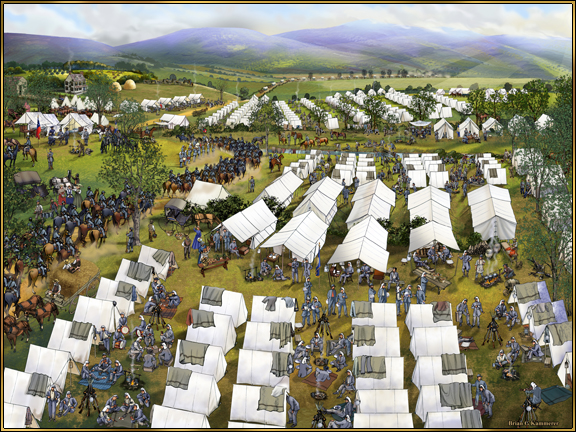
Click here to view close up cropped images of this print
Camping in the open air was new to many of the men and boys that filled the ranks of the assembling armies. Officers were well advised to keep the soldiers busy after a day of drill with arduous tasks that maintained the army in the field. Wood needed to be gathered for heat and fuel. Potable water became a problem. Thousands of men and animals using the same water source quickly fouled the stream. Some of the boys were accustomed to life out doors and the daily chores that came with running a farm. The hard labor of army life was a shock to those that until recently were merchants, book keepers, students and school teachers. There were latrines to dig, a camp to keep clean and guard, horses and mules to feed and care for. Now these men were porters and laborers and subject to a life of “necessary” drudgery. The novelty of soldiering quickly wore off as the tedium of camp life became apparent. The day ended with a regimental dress parade and inspection. This routine kept the men hopping before super at 6:30 and lights out at nine. Card games were a favorite way to pass the time along with letter writing to loved ones who worried about their sons , fathers and husbands.

Camp Chores
When drill was finished there was guard duty for some but for the others it was back to camp to clean ones kit and prepare the evening meal. Those guilty of infractions were put on display to deter any other would be rule breakers. Letters would be written to loved ones and if a photographer happened to be visiting the camp, a carte de vise would someday be sent along. Various amusements occupied the soldiers after parade to suit the taste of different company's. For those not assigned for the gathering of wood or preparing the evening meal, horseshoes or a card game would pass the time nicely. The men began to feel right at home. “The soldiers life for me,” some said.

Richmond-1861
Click here to view close up cropped images of this print
The newly established Capitol at Richmond saw the influx of State militia units and new recruits on a daily basis. Space was becoming a premium in the city. Camp Lee was the main assembly area at the end of Broad Street. The cavalry were bivouacked at the city race course. The delight and vices of the city were a temptation to many. Guards were posted to keep the men in check but many managed to slip away. One northern soldier told his family that “ if there is any place on God’s fair earth where wickedness ‘stalketh abroad in daylight,’ it is in the army.”
I have used Belle Island which became a holding area for Northern troops later in the war as a setting for this idyllic pre war setting. The Washington Artillery of New Orleans even brought striped tents to compliment the scene. As the sun sets beyond the hills of life as they knew it to be, so too will the dawn bring a new experience that few could conceive. The men have had their supper and now gather to play checkers
